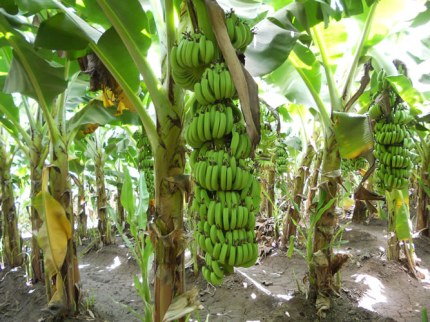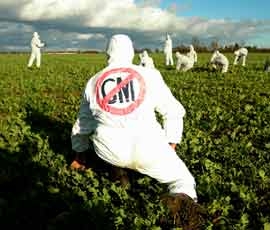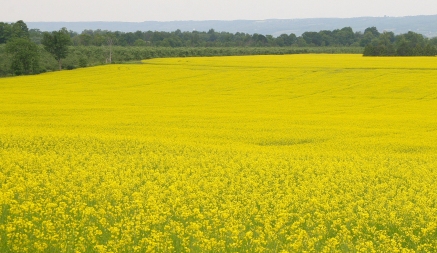That’s a serious challenge for those hoping new genetic technologies will evade opposition
I am a long-time champion of the use of agricultural biotechnology dating back to the mid 1990s when, as a farm organization executive, I lobbied actively for the first biotech crop regulatory approval in Canada (Bt corn). We proudly grow Bt corn and herbicide-tolerant (HT) corn and soybeans on our farm, and would welcome biotech enhancements for other crops too.
But I have also tried hard to understand the position of those who oppose GM (‘genetically modified’) crops. (I prefer the term GE, ‘genetically enhanced,’ but for this column I’ll call everything GMOs as that’s the term most others use.) I’ve read their materials, attended conferences, and had one-on-one discussions. GMO opponents have been guests on our farm.
This interaction has been difficult for me as one who deeply appreciates what the combination of the agriculture and science, especially crop genetic improvement, has meant for farmers and consumers. Discussion with those who largely reject it all is not easy.

It would be simpler if their opposition was limited to herbicide-resistant crops. As a farmer I know the benefits, but someone opposed to all synthetic pesticide usage would not likely understand. Easily overlooked are ‘details’ like: use of glyphosate-resistant crops means less usage of other herbicides and less soil tillage – and glyphosate herbicide, with its patent expired, can be purchased from companies other than Monsanto.
But how to explain it when the opposition to HT-GMOs usually does not include herbicide-tolerant crops derived in other ways – for example, by using mutation breeding or extensive natural selection? (To be fair, some anti-GMO advocates have condemned these too, but they have in turn been criticized by organic growers who accept the use of mutagen-derived crops.)
Opposition to insect-tolerant crops, like Bt corn, cotton and Brinjal (a type of egg plant grown in south-east Asia) is more difficult to understand when it clearly means less pesticide usage and reduced damage from secondary pathogens (like toxin-producing ear moulds in the case of Bt corn) – and when the transferred gene comes from a soil bacterium (Bacillus thuringiensis) used as an organic insecticide itself.
Most difficult for me to comprehend is the intense opposition by well-resourced (and presumably well-informed) environmental NGOs to the development of biotech solutions for third-world nutritional and health issues: for example, Golden Rice involving the transfer of a corn gene into rice to help counter the blindness and deaths caused by Vitamin A deficiency in many poor countries (link). Or the transfer of a gene from sweet pepper into bananas to help Ugandan farmers protect their crop from a devastating Xanthomonas bacterial disease (link). The opposition is sometimes so extreme as to include destroying research plots, thus rejecting even the testing of potential solutions if they involve transgenic changes

A common explanation among many supporters of agricultural biotechnology is that anti-GMO activism is driven by money. That is undoubtedly true in many cases – for example, organic or ‘natural food’ marketers who have supported anti-GMO campaigns in an attempt to increase sales. It’s true for companies like Genetic ID which find it profitable to test crops and foods for GMO content, while at the same time aggressively supporting anti-GMO campaigns and GMO/non-GMO food product labelling.
In this category we can place some more traditional food marketers eager to exploit a marketing niche. The Chipotle Mexican Grill Company is a high-profile example.
But this is far from true for all anti-GMO campaigners – either individuals or multinational NGOs. Greenpeace, for example, may have attracted additional donations because of its campaign against Golden Rice, but the same effort has also cost it serious credibility in the broader context. Is Greenpeace really that callous to third-world blindness? How can you trust what Greenpeace says on climate change when the same group destroys GM crop plots in The Philippines while seeking extended bans because of insufficient field data.
The issue of climate change may in fact provide the best clue on what drives the anti-GMO campaign. For it’s here that the irrationality of the antis’ position becomes most apparent for anyone committed to science. This is the dilemma which caused Mark Lynas to switch from anti-GMO to pro-GMO, via his ‘coming out’ speech at the Oxford Farming Conference in January 2013. How can you argue the case for climate change using scientific consensus as the rationale, and at the same time ignore an even greater scientific consensus in favour of the safety of approved genetically modified crops and foods?
To get around this, anti-GMO advocates tout those relatively rare ‘outlier’ studies purporting to show harmful effects of GMO crops. And they take great offence when critical flaws in these various studies are exposed. Take the work of Pusztai on potatoes, or Séralini on glyphosate and HT corn, or Carman on GMO corn and soybeans as examples – all exposed for their critical flaws – but still treated as sacred by those for whom all GMOs are bad.
By contrast, major scientific reviews such as that by Niolia et al in Italy (accessible here), analyzing 1783 studies and finding no evidence of negative effect of GM-derived crops and foods on human health, have been largely ignored by anti-GMO folks or simply dismissed as industry propaganda. This is even though many hundreds of the studies reviewed involved no industry funding.
But if you set science aside, you can see something in the positions of the ‘antis’ which does make sense:
The positions of major NGOs on GMOs and climate change are quite consistent if one considers that the real issue is not opposition to GM technology, but rather to large petro/chemical companies. Large petro/oil companies commonly profit from fossil fuel usage; therefore policies which mean reduced fossil fuel usage are applauded. Large chemical/bio companies benefit from GMO crop technology; therefore, GMO crops are opposed.
Opposition to these corporations is the common element.

I realize that this ‘revelation’ is hardly a secret. The writings of anti-GMO groups are full of preaching about the evils of big business – especially big business in agriculture and food. A high-profile Canadian, Naomi Klein, has made a career of corporate bashing, including GMO and oil-company bashing, and she has many disciples. The Indian evangelist, Vandana Shiva, goes further in attacking all forms of advanced crop breeding, including Green Revolution advances, as part of her campaign against Western capitalism.
If you accept this perspective, then other inconsistencies become less incompatible, as well:
Why did we hear scarcely a peek of objection when crop scientists/geneticists were making major unnatural changes to plant genomes in the days before Bt and HT crops – using techniques like X-ray and gamma-ray bombardment, or the use of chemical mutagens which can even change chromosome numbers? I recall barley breeding at the University of Guelph back in the 1960s using tissue culture, chemicals and radiation to create barley germplasm which was ‘different.’ (I helped plant those plots as an undergrad assistant.) The same for the transgenic wheat varieties produced in France decades ago including one still favoured by organic growers. With both non-natural Canadian high-tech barley and transgenic French wheat no special testing was required for safety or environmental risk.
The explanation lies not in the technology, but in the technologists: In those days, these were virtually all university and government researchers, not commercial seed companies (and definitely not commercial seed companies owned by chemical companies). If the first large-scale transgenic crops had been produced and marketed by public breeders, likely no major NGO would have paid any attention. Who would have heard of GMO-papaya, created by a University of Hawaii plant breeder to address a local disease problem, if not for reaction to large scale Bt and HT corn, soybeans, cotton and canola developed and introduced by Monsanto at about the same time?
It’s true that Monsanto contributed significantly to its own fate. I remember how Robert Shapiro, CEO of Monsanto at the time, bragged widely about the new world of agriculture and food to be dominated by his company. Monsanto was aggressive in buying up seed companies.
I recall asking a contact in Greenpeace Canada in the late 1990s whether they couldn’t distinguish between Monsanto (whose swagger also annoyed farmers) and biotechnology (the products of which many farmers loved). His response was that Greenpeace liked things to be simple – good versus evil, not shades of grey – and the combination of an American chemical company, corporate arrogance and new unknown technology was a perfect target.
The message of ‘big chemical companies playing God’ with food plants and animals has broad appeal. This is especially so in an era when many suppliers are attempting to label their food product as ‘natural,’ regardless of the amount of human intervention which has occurred since the associated plant or animal existed in the wild state.
Large changes have occurred in Monsanto since the Shapiro ceased being CEO. In many ways the company has become a model corporate citizen. But the damage was done.

That desire for a simple, good-versus-evil portrayal helps to explain some other inconsistencies in the anti-GMO messaging:
- Other chemical companies are heavy into ‘conventional breeding’ including BASF, the champion of ‘Clearfield’ technology (herbicide-resistant crops derived from natural selection or mutation breeding), but no public criticism of that. (The target seems to be whether a process is ‘Monsanto-like,’ and not so much about the trait of the resulting crop per se.) Also overlooked is the fact that Monsanto is not particularly large. For example, it’s dwarfed by both BASF and DowDuPont, both chemical company competitors. Indeed, Monsanto’s annual sales are about the same as those for Whole Foods.
- The technologies used to produce GM crops are about the same as those for many human drugs including human insulin and many of the companies involved are the same. It’s true that most drug biotechnology involves microorganisms and not higher plants or animals. However, a strain of genetically modified chickens was recently approved for human drug production – with scarcely a peep from the anti-GMO folks.
- ‘Bigness’ is not an obstacle to the acceptance of all high-tech products. Consider iPhones and iPads from the biggest company of all, Apple. (That Steve Jobs, founder and CEO of Apple, was a far more obnoxious person than Shapiro does not enter the discussion.) However, ‘anti-big corporation’ is a theme which does resonate with many more people, and that helps explain why the activists’ message has appeal. People, by and large, do not trust big companies, and a stream of news about big-company screw-ups and high corporate salaries has not helped their cause.
Big ag companies have the added disadvantage that consumers see few direct advantages from their innovations and operations. (‘Benefits go to corporate shareholders and farmers,’ they think, overlooking long-term payoffs in increased food supply and reduced relative household expenditures for food.)

Biotech researchers and companies have recently developed several new biotech approaches for changing the expression of plant genes. Many people in the agricultural-biotechnology industry believe these new technologies will help them circumvent opposition to crop transformations produced using ‘classical’ GM transgenic methodologies. Many new biotech products involve within-species transfers, or the ‘turning off’ or elimination of specific genes. A new technology called RNAi (RNA interference) includes the direct application (spraying) of RNA molecules onto commercial crops to modify or prevent gene action. There is likely no change in basic plant DNA at all.
Nathanael Johnson of Grist magazine has written a great article outlining the diversity of technologies, and the overlap between ‘natural’ and manmade, while asking the question, can the term ‘GMO’ even be defined?
The bigger question is: Will the new technology and the diversity stem the opposition by activists? There are two possible answers:
If the opposition is not really to technology itself but rather to big agribusinesses, then the answer is likely no: Because the new biotechnologies are mostly being introduced by ‘big ag’ companies, the result will be viewed by many activists as changing nothing. Big companies are still in charge.
However, if the result is to make the issues more complex – a myriad of technologies, a continuum of technologies – including some in common usage for decades and indeed accepted for use in organic agriculture – this detracts seriously from the black-and-white, good-versus-evil characterization which works best for the anti-GMO crowd. It certainly complicates life for the ‘Just label it’ crowd. ‘Just label what?’
We are already seeing that confusion playing out at high levels. Sweden has announced that genetic change created by the new gene-changing ‘CRISPR-Cas9’ biotechnology is not to be considered a GMO – a crack in the strongly anti-biotech fortress mentality of many EU politicians.
It may be more difficult for NGOs to attack a diffuse array of technologies producing products perceived to have more public benefits – for example, non-browning apples and potatoes or seafood causing less environmental burden. It’s significant too that some of these new, consumer-friendly products, are coming from small companies and not chemical industry giants at all.
But if NGOs are willing to attack Golden Rice promising life and vision for millions of children and developed by the (very public) International Rice Research Institute (they label this as but a callous ‘Trojan horse’ designed to portray GMOs in a deceptively positive light), are they likely to leave other beneficial products alone? The speed with which they have moved to pressure large retailers/users like McDonalds and Costco into statements of rejection of Innate® potatoes or Aqua Bounty® salmon, years before these products could even be available in sufficient quantities to supply large markets, is evidence of how seriously NGOs view the ‘Trojan horse’ threat.
The NGOs are powerful, well-funded, remarkably good at media messaging, and have good track records of success. On the other side, the big companies whom they condemn will play a continuing major role in meeting human nutritional needs in the years ahead while using new science and technology to help meet these goals. Yes, this is even so in the case of organic and ‘natural’ foods.
This battle is far from over.
